Motorola CLS446, PMR446 User Manual

Contents
Safety And General Information |
2 |
Call Tones and Vibrate Feature |
13 |
|
Transmit and Receive Procedure |
2 |
Scan |
13 |
|
Exposure to Radio Frequency Energy |
2 |
Voice Scrambling |
14 |
|
Portable Radio Operation and EME Exposure |
3 |
Microphone Gain |
14 |
|
Electromagnetic Interference/Compatibility |
3 |
Signal Strength and Channel Busy Indicator |
14 |
|
Safety and General Use While Driving |
4 |
Keypad Lock |
15 |
|
Operational Warnings |
4 |
Roger Beep (Talk Confirmation Tone) |
15 |
|
Operational Cautions |
5 |
Time-Out Timer |
15 |
|
Charger Safety Instructions |
5 |
Keypad Tones |
15 |
|
Getting Started |
7 |
Battery Save Mode |
15 |
|
Restore Factory Defaults |
15 |
|||
Diagram of your radio |
7 |
Fitting the Swivel Holster |
16 |
|
Your New Radio |
8 |
Further Information |
16 |
|
Turning Your Radio On and Off |
8 |
|||
Talk Range |
16 |
|||
Radio Etiquette |
8 |
|||
Troubleshooting |
17 |
|||
Batteries and Battery Charging |
8 |
|||
Use and Care |
19 |
|||
|
|
|||
Talking And Listening |
12 |
Specifications |
19 |
|
Setting the Channel |
12 |
Warranty Information |
20 |
|
Setting the Code |
12 |
Copyright Information |
20 |
|
Features |
12 |
|
|
|
Hands Free Use (VOX) |
12 |
|
|
English
1

English
Safety and General Information
Important Information on Safe and Efficient Operation Read This Information Before Using Your Radio
The information provided in this document supersedes the general safety information contained in user guides published prior to July 2000.
Transmit and Receive Procedure
Your two-way radio contains a transmitter and a receiver. To control your exposure and ensure compliance with the general population/uncontrolled environment exposure limits, always adhere to the following procedure:
•Transmit no more than 50% of the time.
•To transmit (talk), press the Push to Talk (PTT) button.
•To receive calls, release the PTT button.
Transmitting 50% of the time, or less, is important because the radio generates measurable RF energy exposure only when transmitting (in terms of measuring standards compliance).
Exposure to Radio Frequency Energy
Your Motorola radio is designed to comply with the following national and international standards and guidelines regarding exposure of human beings to radio frequency electromagnetic energy:
•United States Federal Communications Commission, Code of Federal Regulations; 47 CFR part 2 sub-part J
•American National Standards Institute (ANSI)/Institute of Electrical and Electronic Engineers (IEEE) C95. 1-1992
•Institute of Electrical and Electronic Engineers (IEEE) C95.1-1999 Edition
•International Commission on Non-Ionizing Radiation Protection (ICNIRP) 1998
•Ministry of Health (Canada) Safety Code 6. Limits of Human Exposure to Radio Frequency Electromagnetic Fields in the Frequency Range from 3 kHz to 300 GHz, 1999
•Australian Communications Authority Radiocommunications (Electromagnetic Radiation - Human Exposure) Standard 2003 (applicable to wireless phones only)
•ANATEL, Brasil Regulatory Authority, Resolution 256 (April 11, 2001) "additional requirements for SMR, cellular, and PCS product certification."
To assure optimal radio performance and make sure human exposure to radio frequency electromagnetic energy is within the guidelines set forth in the above standards, always adhere to the following procedures.
2

Portable Radio Operation and EME Exposure
Antenna Care
Use only the supplied or an approved replacement antenna. Unauthorized antennas, modifications, or attachments could damage the radio and may violate FCC regulations.
DO NOT hold the antenna when the radio is "IN USE." Holding the antenna affects the effective range.
Two-Way Radio Operation
When using your radio as a traditional two-way radio, hold the radio in a vertical position with the microphone one to two inches (2.5 to 5 cm) away from the lips.
Body-Worn Operation
To maintain compliance with FCC/Health Canada RF exposure guidelines, if you wear a radio on your body when transmitting, always place the radio in a Motorolasupplied or approved clip, holder, holster, case, or body harness for this product. Use of non-Motorola-approved accessories may exceed FCC/Health Canada RF exposure guidelines. If you do not use one of the Motorola-supplied or approved body-worn accessories, and are not using the radio held in the normal use position, ensure the radio and
its antenna are at least one inch (2.5 cm) from your body when transmitting.
Data Operation
If applicable, when using any data feature of the radio with or without an accessory cable, position the radio and its antenna at least one inch (2.5 cm) from the body.
Electromagnetic Interference/Compatibility
Note: Nearly every electronic device is susceptible to electromagnetic interference (EMI) if inadequately shielded, designed, or otherwise configured for electromagnetic compatibility.
Facilities
To avoid electromagnetic interference and/or compatibility conflicts, turn off your radio in any facility where posted notices instruct you to do so. Hospitals or health care facilities may be using equipment that is sensitive to external RF energy.
Aircraft
When instructed to do so, turn off your radio when on board an aircraft. Any use of a radio must be in accordance with applicable regulations per airline crew instructions.
English
3

English
Medical Devices - Pacemakers
The Advanced Medical Technology Association recommends that a minimum separation of six inches (15 cm) be maintained between a handheld wireless radio and a pacemaker. These recommendations are consistent with the independent research by, and recommendations of the U.S. Food and Drug Administration.
Persons with pacemakers should:
•ALWAYS keep the radio more than six inches (15 cm) from their pacemaker when the radio is turned ON.
•Not carry the radio in the breast pocket.
•Use the ear opposite the pacemaker to minimize the potential for interference.
•Turn the radio OFF immediately if you have any reason to suspect that interference is taking place.
Medical Devices - Hearing Aids
Some digital wireless radios may interfere with some hearing aids. In the event of such interference, you may want to consult your hearing aid manufacturer to discuss alternatives.
Other Medical Devices
If you use any other personal medical device, consult the manufacturer of your device to determine if it is adequately
shielded from RF energy. Your physician may be able to assist you in obtaining this information.
Safety and General Use While Driving
Check the laws and regulations on the use of radios in the area where you drive. Always obey them. When using your radio while driving, please:
•Give full attention to driving and to the road.
•Use hands-free operation, if available.
•Pull off the road and park before making or answering a call if driving conditions so require.
 Operational Warnings
Operational Warnings
For Vehicles With An Air Bag
Do not place a portable radio in the area over an air bag or in the air bag deployment area. Air bags inflate with great force. If a portable radio is placed in the air bag deployment area and the air bag inflates, the radio may be propelled with great force and cause serious injury to occupants of the vehicle.
Potentially Explosive Atmospheres
Turn off your radio prior to entering any area with a potentially explosive atmosphere, unless it is a radio type especially qualified for use in such areas as "Intrinsically
4

Safe." Do not remove, install, or charge batteries in such areas. Sparks in a potentially explosive atmosphere can cause an explosion or fire resulting in bodily injury or even death.
Note: The areas with potentially explosive atmospheres referred to above include fueling areas such as below decks on boats, fuel or chemical transfer or storage facilities, areas where the air contains chemicals or particles, such as grain, dust or metal powders, and any other area where you would normally be advised to turn off your vehicle engine. Areas with potentially explosive atmospheres are often but not always posted.
Blasting Caps and Areas
To avoid possible interference with blasting operations, turn off your radio when you are near electrical blasting caps, in a blasting area, or in areas posted: "Turn off twoway radio." Obey all signs and instructions.
 Operational Cautions
Operational Cautions
Antennas
Do not use any portable radio that has a damaged antenna. If a damaged antenna comes into contact with your skin, a minor burn can result.
Batteries
All batteries can cause property damage and/or bodily injury such as burns if a conductive material such as jewelry, keys, or beaded chains touch exposed terminals. The conductive material may complete an electrical circuit (short circuit) and become quite hot. Exercise care in handling any charged battery, particularly when placing it inside a pocket, purse, or other container with metal objects.
Charger Safety Instructions
Before using the battery charger, read all instructions and cautionary markings on:
1.the battery
2.the battery charger, and
3.the radio using the battery.
Caution: To reduce the risk of injury, only charge the Motorola approved rechargeable battery for this product. Other types of batteries may burst, causing personal injury and damage.
English
5

English
6
Save these Instructions
1.Do not expose the charger to rain or snow.
2.Do not operate or disassemble the charger if it has received a sharp blow, or has been dropped or damaged in any way.
3.Never alter the AC cord or plug provided with the unit. If the plug will not fit the AC outlet, have the proper outlet installed by a qualified electrician. An improper condition can result in a risk of electric shock.
4.To reduce the risk of damage to the cord or plug, pull the plug rather than the cord when disconnecting the charger from the AC outlet.
5.To reduce the risk of electric shock, unplug the charger from the AC outlet before attempting any maintenance or cleaning.
6.Use of an attachment not recommended or sold by Motorola may result in a risk of fire, electric shock, or personal injury.
7.Make sure the cord is located so it will not be stepped on, tripped over, or subjected to damage or stress.
8.An extension cord should not be used unless absolutely necessary. Use of an improper extension cord could result in a risk of fire and/or electric shock. If an
extension cord must be used, make sure:
•That the pins on the plug of the extension cord are the same number, size, and shape as those on the plug of the charger.
•That the extension cord is properly wired and in good electrical condition, and
•That the cord size is 18 AWG (1mm2) for lengths up to 100 feet (30 metres) and 16 AWG (1.3mm2) for lengths up to 150 feet (45 metres).
9.The supply cord of this charger cannot be replaced. If the cord is damaged please return to your place of purchase.

Getting Started
Diagram of your radio
Use Pto:
Turn radio on or off
Adjust radio volume
Use Bto:
Transmit call tone
Use Tto:
Monitor the frequency
Scan channels
Use Sto:
Lock the keypad
Scroll through menus
English
LED indicator lamp
Microphone
Accessory jack
Use Push to Talk (PTT) to:
Talk
Save a setting
Use ]and [to: Change channels and codes
Change menu settings
Speaker
7
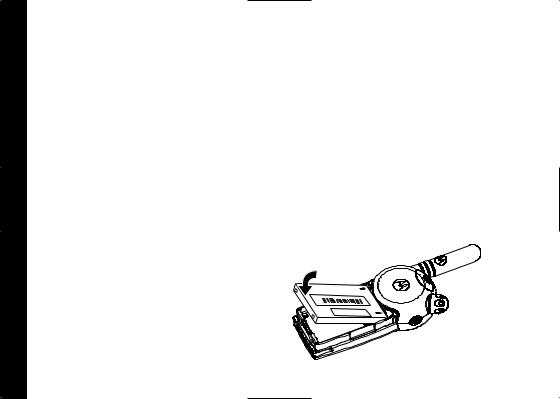
English
Your New Radio
Motorola CLS446 two-way radios operate on PMR446 frequencies, and can be used in any country where PMR446 frequencies are authorized, subject to applicable regulations. This license-free, two-way radio service is for family and group recreational use. Use of this radio outside the country where it was intended to be distributed is subject to government regulations and may be prohibited. Read this manual carefully and make sure you know how to properly operate the radio before use.
Please retain your original dated sales receipt for your records. For warranty service of your Motorola two-way radio you will need to provide a copy of your dated sales receipt to confirm warranty status.
Turning Your Radio On and Off
Turn Pclockwise to turn the radio on, and adjust the volume to a comfortable level. The radio will beep and both the red LED and the segments on the display will illuminate briefly. Turn Panticlockwise to turn the radio off.
Radio Etiquette
It is good radio etiquette to monitor the channel for activity before you transmit, to ensure that you do not interrupt other users already on the channel. Press and hold T
briefly to check for channel activity.If you hear static, the channel is clear for use. Press Tagain to stop monitoring.
Batteries and Battery Charging
Your CLS446 radio operates with a rechargeable Lithium Ion (Li Ion) battery. A battery tray is available which allows 3 AAA alkaline batteries to be used. Please contact your dealer or retailer for more information.
Installation of Li Ion Battery
•Press the dimple on the battery door to release the clip and slide it off the radio.
•Insert the battery, printed arrows first, into the battery compartment and press into place.
•Slide and snap the battery door into place.
8
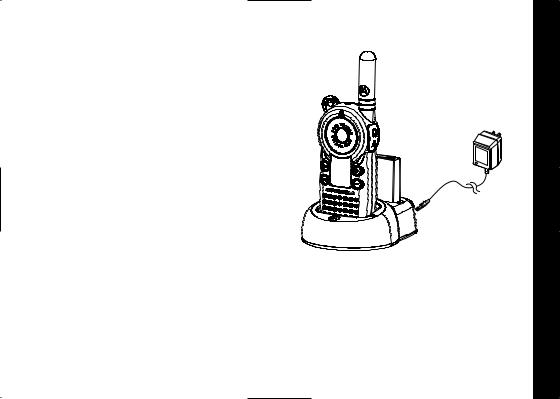
Installation of AAA Batteries
•Press the dimple on the battery door to release the clip and slide it off the radio.
•Insert 3 AAA batteries into the battery tray as shown by the markings inside the tray.
•Insert the battery tray into the battery compartment and press into place.
•Slide and snap the battery door into place.
•Press Suntil Aor nflashes (this menu does not appear if using a Motorola Li Ion battery).
•Press ]or [to select Afor alkaline batteries, or nfor rechargeable AAA cells.
Charging the Battery
Use only the charger supplied with the radio, or other _Series power accessories. For optimum battery life, do not charge the battery for prolonged periods after it is fully charged. Charging the battery over the weekend is acceptable.
Using the Drop-in Charger
•Place the charger on a flat surface.
•Insert the jack plug of the power supply into the jack socket on the charger.
•Plug the power supply into a standard AC wall socket.
•Ensure radio is off. If the radio is on while charging, it will take longer to fully charge.
•Insert the radio (with battery installed) into the front section of the charging pocket.
English
9
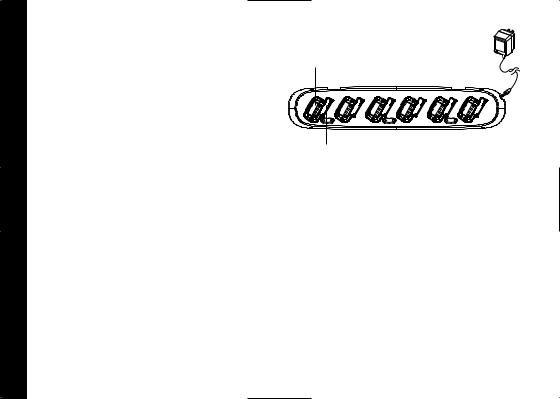
English
10
Note: The radio will fit in the charger with the holster on.
The drop-in charger will also sequentially charge a spare SNN5571 Li Ion battery. The spare battery will not begin to charge until the radio battery is fully charged. Both batteries will charge in approximately 2–6 hours.
Using the Optional Multi Unit Charger
Please contact your dealer or retailer for more information.
The Multi-Unit Charger (MUC) allows drop-in charging of up to 6 radios or batteries. Batteries can be charged inside the radios or removed and placed in the MUC separately. Each of the 6 charging pockets can hold a radio or battery, but not both.
•Place the charger on a flat surface.
•Insert the jack plug of the power supply into the jack socket on the MUC.
•Plug the power supply into a standard AC wall socket.
•Ensure radio is off.
•Insert the radio or battery into the charging pocket.
Radio Charging Pocket
Battery Charging Pocket
Cloning
The cloning feature is available with the MUC. This enables you to copy your radio's settings to other radios. Please refer to the user manual supplied with your MUC.
Charging LEDs
On the drop-in charger, the radio and battery charging pockets have their own LEDs. On the MUC, each of the 6 charging pockets has an LED. The LEDs are grouped into pairs to show which charging pockets are paired.
The LED is solid red when the battery is charging, and solid green when charging is complete.

The Battery Meter
The battery meter in the upper left corner of the display shows how much battery power is remaining.
Battery Type |
3 Bars |
2 Bars |
1 Bar |
Flashing |
|
|
|
|
|
|
d |
b |
c |
m |
|
|
|
|
|
Li Ion |
100%–85% |
85%–25% |
25%–10% |
Final 10% |
|
|
|
|
|
AAA Alkaline |
100%–75% |
75%–40% |
40%–10% |
Final 10% |
|
|
|
|
|
Battery Life
The approximate (typical) battery life for: Li Ion batteries is 12 Hours
AAA Alkaline batteries is 10 Hours
This is based on a 5% transmit, 5% receive and 90% standby cycle
Note: For optimal battery life, high capacity alkaline batteries are recommended.
English
11

English
12
Talking And Listening
Your radio has 8 channels and 121 interference eliminator codes. If you are in a group and you wish to talk to each other, all radios must be set to the same channel and interference eliminator code. If you experience interference and need to change channel, ensure that you change the channel of all radios in your group.
Before talking, please remember to monitor the channel, as described previously. Then press and hold the Push to Talk (PTT) button. When you are finished talking, release the PTT button and the radio will beep (if the talk confirmation tone is enabled). For maximum clarity, hold the radio 5 to 7 cm away from your mouth and speak directly into the microphone. Do not cover the microphone while talking.
Setting the Channel
•Press Suntil the channel number flashes.
•Press ]or [to select a channel.
•Press PTT to confirm.
Setting the Code
•Press Suntil the code number flashes.
•Press ]or [to select a code.
•Press PTT to confirm.
You can specify a different code for each channel
•To set a channel and code combination, press Sand then press ]or [to select the channel.
•Press Sagain and then press ]or [to select a code.
•Press PTT to exit the menu and to save the channel and code combination.
Features
Hands Free Use (VOX)
VOX allows you to transmit "hands free" by talking while using VOX accessories connected to the radio. A VOX compatible headset is supplied with your radio.
Note: When using audio accessories with your radio, turn the volume of your radio down before you place the accessory on your head or in your ear.
To Use The VOX Feature:
•Switch off your radio.
•Open the accessory cover and insert the audio accessory into the accessory jack. If the VOX icon gis flashing and
you are setting up VOX for the first time, set the VOX sensitivity level (please see below).
•Switch on your radio. The gicon will appear in the display to indicate that the VOX feature is active.
•To transmit, speak into the accessory microphone. To receive, stop talking.

•Pressing PTT or removing audio accessory will disable VOX operation.
Note: There is a short delay after you start talking, before the radio transmits.
Setting Sensitivity Levels
Adjusting your radio’s VOX sensitivity level helps to minimize the possibility of unintended noises triggering a transmission, or enhances the ability to pick up quiet voices.
•With an audio accessory fitted, press Suntil gand H show in the display.
•Press ]or [to select the sensitivity level as follows: 1- If you speak loudly, or are in a noisy environment. 2- Suitable for most applications.
3- If you speak softly, or are in a quiet environment.
•Press PTT to set level.
Call Tones and Vibrate Feature
Your radio can transmit call tones to other radios in your group so you can alert them that you are about to talk. Your radio is programmed at the factory with call tones turned off (set to 0), but you can change this setting to choose a distinctive call tone.
The vibrate feature is an additional call tone option that makes your radio vibrate briefly when it receives (if you
have not transmitted or received in the last 30 seconds). Select call tone 4to turn the vibrate feature on. iwill show in the display.
To Set the Call Tone
•Press Suntil Eappears in the display.
•Current call tone setting 0-4will begin to flash.
•Press ]or [to change and hear call tones while the setting number is flashing. If you set call tone to 4you
will feel the radio vibrate as well as hearing the call tone.
•Press PTT to set new call tone.
To transmit your call tone, press Bwhich is on the left side of the radio.
Scan
Use scan to monitor channels for transmissions, or to find someone in your group who has accidentally changed channels.
To Use The Scan Feature:
•Press S. The display shows hand the radio begins to
scan the channels. When the radio detects activity, it stops on that channel and displays wand the channel
number.
•To talk to the person transmitting without switching channels, press PTT within 5 seconds. If PTT is not
English
13

English
14
pressed within 5 seconds, scanning resumes.
• To stop scanning, briefly press T.
If you press PTT while the radio is scanning, the radio transmits on the channel you were on before you started scanning.
Skipping and Scanning
Scan has two temporary features to make it easier to use:
1.Scan advance: If the radio stops scanning on a channel you do not want to listen to, press ]to resume
scanning for the next active channel.
2.Nuisance delete: Press and hold [to temporarily remove a channel from the scan list. The channel returns the next time you use the scan feature.
Editing the Scan List
For faster scanning and to avoid hearing unwanted transmissions, you can edit the scan list to skip channels.
•Press Suntil hdisplays and the channel number and Y or nflash.
•Press ]or [to select the channel you want to remove from the scan list.
•Press Tto display either Yto include the channel or nto exclude the channel.
•Press PTT to exit.
Voice Scrambling
This feature gives you additional privacy. Anyone who is listening on the same channel and code will hear distorted speech, unless they have a voice scrambling code that matches yours.
•Select the channel on which you wish to set up the voice scrambling code.
•Press Suntil eshows in the display.
•Use ]or [to select the required code. (code 0 disables the voice scrambling code).
•Press PTT to exit.
Microphone Gain
Adjusting your radio’s microphone sensitivity level helps to minimize the possibility of unintended noises triggering a transmission, or enhances the ability to pick up quiet voices.
•Press Suntil gand ?show in the display.
•Press ]or [to select the sensitivity level as follows: 1- If you speak loudly, or are in a noisy environment. 2- Suitable for most applications.
3- If you speak softly, or are in a quiet environment.
•Press PTT to set level.
Signal Strength and Channel Busy Indicator
If another radio is transmitting on your set channel and code wwill show in the display and the red LED will flash

at a faster rate of once per second. The strength of the received signal will be between 1(weakest) and 6 (strongest). The icon will also display a strength scale between vand p. This feature can help determine when a radio in your group is moving out of range.
Note: Obstacles that block the signal path may affect the strength of the incoming signal.
Keypad Lock
You can lock the keypad to avoid accidentally changing your radio settings.
•Press and hold Sfor 3 seconds.
•To unlock, press and hold Sfor 3 seconds.
Roger Beep (Talk Confirmation Tone)
When you enable this feature, your two-way radio transmits a unique tone when you finish transmitting. It’s like saying 'Roger' or 'Over', and lets others know you’ve finished talking. Your radio is programmed at the factory with roger beep turned off.
•To enable the roger beep, press and hold ]as you turn your radio on.
•When you release the PTT button you will hear the roger beep.
•To disable the roger beep, press and hold ]as you turn your radio on.
Time-out Timer
The Time-out Timer feature helps extend battery life by preventing you from accidentally transmitting. The radio will emit a continuous warning tone after PTT is pressed for 60 continuous seconds and will stop transmitting.
Keypad Tones
Every time you press a button on your radio's keypad it beeps to confirm unless you disable the tones. Your radio is programmed at the factory with keypad tones turned on.
•To disable the tones, hold down [while switching on your radio.
•When you press any button on the keypad you will no longer hear the tone.
•To enable, again hold down [while switching on your radio.
Battery Save Mode
When this feature is disabled (factory default is on) it improves the attack time, which is the brief period of time between when the radio receives a transmission and the sound coming out of the speaker. However this decreases battery life by approximately 20%.
Restore Factory Defaults
This returns radio to its original factory settings. Hold down PTT and Swhile switching on your radio.
English
15
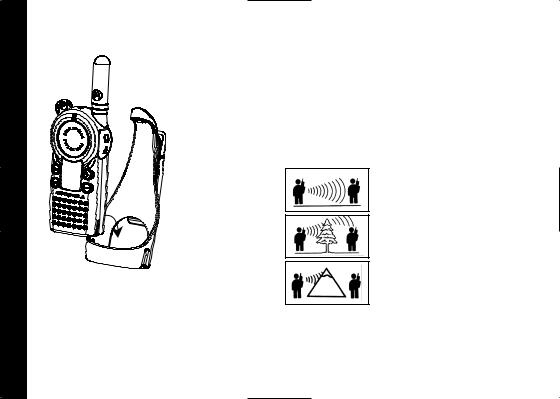
English
16
Fitting the Swivel Holster
•Slide the bottom of the radio into the holster until it snaps into place.
•To remove, push the tab on the holster and pull the radio away from the holster.
Further Information
Talk Range
Your radio has been designed to maximize performance and improve transmission range in the field. It is recommended that you do not use the radios closer than 1.5 meters apart, to avoid interference.
Talk range depends on the terrain. It will be affected by concrete structures, heavy foliage and by operating radios indoors or in vehicles.
Optimal Range Outdoors
Flat, open areas
Medium Range Outdoors
Buildings or trees
Also near residential buildings
Minimal Range Outdoors
Dense foliage or mountains
Also inside some buildings
Optimal range occurs in flat, open areas, with up to 3 kilometres of coverage. Medium range occurs when buildings and trees are in the way. Minimal range occurs when dense foliage and mountains obstruct the communication path.

Troubleshooting
No power |
• Recharge or replace Li Ion battery. |
|
• Reposition or replace alkaline batteries. |
|
|
Message not transmitted |
• Make sure PTT button is completely pressed while you transmit. |
|
• Reposition, replace or recharge batteries. |
|
• Verify the red LED is illuminated while speaking. |
|
• Confirm channel and code settings are correct. |
|
|
Message not received |
• Confirm all radios have same channel and code settings. |
|
• Make sure PTT button is not inadvertently being pressed. |
|
• Reposition, replace or recharge batteries. |
|
• Obstructions, and operating indoors or in vehicles may interfere with communication. |
|
Change your location. |
|
• Check to make sure volume is turned up. |
|
• Verify radio is not in scan mode. |
|
|
Hearing other conversation |
• Shared channel may be in use, try another. |
or noise on a channel |
|
|
|
Limited talk range |
• Steel or concrete structures, heavy foliage and use in buildings and in vehicles will |
|
decrease range. Check for clear line of sight to improve transmission. |
|
• Wearing radio close to body such as in a pocket or on a belt will decrease range. |
|
Change location of radio. |
|
|
Heavy static or interference |
• Radios too close. Radios must be at least 1.5 metres apart. |
|
• Radios too far apart. Obstacles interfere with transmission. |
English
17

English
Keypad Locked |
• Unlock by holding Sfor 3 seconds. |
|
|
Low batteries |
• Recharge or replace batteries. Extreme operating temperatures affect battery life. |
|
|
Charger light does not come on |
• Reinsert radio and/or battery. |
|
• Clean battery and/or charger contacts. |
|
• Verify that the charging pin on the transformer is inserted correctly into the drop-in |
|
charger. |
|
• AAA cells installed in radio. Remove and replace with Li Ion battery. |
|
|
Low battery meter reading |
• Check radio is set to the correct battery type. |
although new batteries |
• Verify high-capacity alkaline batteries are used for optimal battery life. |
are installed |
|
|
|
Cannot activate VOX |
• Feature not set and on. |
|
• Sensitivity set to 0. |
|
• Verify that accessory is VOX compatible. |
18

Use and Care
To clean radio:
•Use a soft damp cloth
•Do not immerse in water
•Do not use alcohol or cleaning solutions
If your radio gets wet:
•Turn it off and remove batteries
•Dry with soft cloth.
•Battery contacts may be wiped with a dry, lint-free cloth
•Do not use until completely dry
Specifications
Channels |
8 |
Codes |
121 |
Operating Frequency |
446.00625-446.09375 MHz |
Talk Range |
Up to 5 kilometres |
Power Source |
Li Ion Battery or 3 AAA |
|
alkaline batteries (with |
|
optional battery tray) |
Type Designation |
CLS446 |
Transmitter Power (Watts) |
0.5 ERP |
Modulation Type |
Phase (Angle) |
Channel Spacing (kHz) |
12.5 |
English
19

English
20
Warranty Information
How to Get Warranty Service
The authorised Motorola dealer or retailer where you purchased your Motorola two-way radio and/or original accessories will honour a warranty claim and/or provide warranty service.
Please return your radio to your dealer or retailer to claim your warranty service. Do not return your radio to Motorola.
In order to be eligible to receive warranty service, you must present your receipt of purchase or a comparable substitute proof of purchase bearing the date of purchase. The two-way radio should also clearly display the serial number. The warranty will not apply if the type or serial numbers on the product have been altered, deleted, removed, or made illegible.
What Is Not Covered By The Warranty
1.Defects or damage resulting from use of the Product in other than its normal and customary manner or by not following the instructions in this user manual.
2.Defects or damage from misuse, accident or neglect.
3.Defects of damage from improper testing, operation, maintenance, adjustment, or any alteration or modification of any kind.
4.Breakage or damage to aerials unless caused directly by defects in material or workmanship.
5.Products disassembled or repaired in such a manner as to adversely affect performance or prevent adequate inspection and testing to verify any warranty claim.
6.Defects or damage due to range.
7.Defects or damage due to moisture, liquid or spills.
8.All plastic surfaces and all other externally exposed parts that are scratched or damaged due to normal use.
9.Products rented on a temporary basis.
10.Periodic maintenance and repair or replacement of parts due to normal usage, wear and tear.
Copyright Information
The Motorola products described in this manual may include copyrighted Motorola programs, stored semiconductor memories or other media. Laws in the United States and other countries preserve for Motorola, certain exclusive rights for copyrighted computer programs, including the exclusive right to copy or reproduce in any form, the copyrighted Motorola programs.
Accordingly, any copyrighted Motorola computer programs contained in the Motorola products described in this manual may not be copied or reproduced in any manner without express written permission of Motorola.
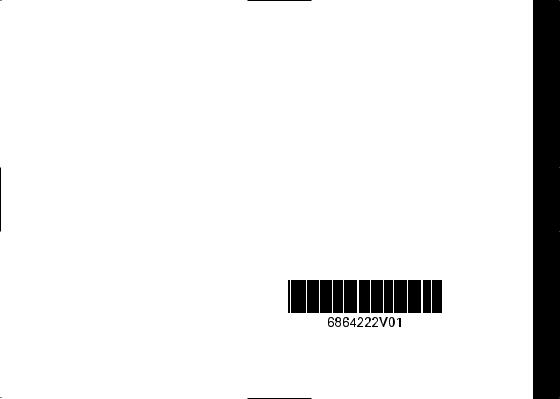
Furthermore, the purchase of Motorola products shall not be deemed to grant either directly or by implication, estoppel, or otherwise, any license under the copyrights, patents or patent applications of Motorola, except for the normal non-exclusive royalty free license to use that arises by operation of law in the sale of a product.
MOTOROLA, the Stylized M Logo and all other trademarks indicated as such herein are trademarks of Motorola, Inc. ® Reg. U.S. Pat. & Tm. Off.
© Motorola, Inc. 2003
WARNING CHOKING HAZARD
SMALL PARTS
Not for children under 3 years. This product is not intended to be used as a toy or plaything.

 0336
0336
For use in:
Austria, Belgium, Denmark, Finland, France, Germany, Iceland, Ireland, Italy, Luxembourg, The Netherlands, Portugal, Spain, Switzerland, United Kingdom, Sweden.
English
21


Sommaire
Informations sur la sécurité et générales |
2 |
Fonction des sonneries d’appel et du vibreur |
13 |
|
Procédure d'émission et de réception |
2 |
Balayage |
14 |
|
Exposition à l'énergie électromagnétique |
2 |
Brouillage de voix |
15 |
|
Utilisation d'une radio portable et exposition a l'énergie |
Gain de microphone |
15 |
||
électromagnetique (EME) |
3 |
Puissance du signal et indicateur de canal occupé |
15 |
|
Interférences/compatibilité électromagnétique |
3 |
Verrouillage du clavier |
15 |
|
Sécurité et utilisation pendant la conduite d'un véhicule 4 |
‘Roger’ Bip (Tonalité de confirmation d’appel) |
15 |
||
Avertissements lors de l'utilisation d'une radio |
4 |
Minuterie de temps écoulé |
16 |
|
Précautions lors du fonctionnement |
5 |
Tonalités de clavier |
16 |
|
Mode d'emploi de sécurité du chargeur |
6 |
Mode économiseur de pile |
16 |
|
Mise en route |
7 |
Restaurer par défaut les paramètres d’usine |
16 |
|
Pose de l’étui à pivot |
17 |
|||
Diagramme de votre radio |
7 |
|||
|
|
|||
Votre nouvelle radio |
8 |
Informations supplémentaires |
17 |
|
Mettre en marche et éteindre votre radio |
8 |
Portée de la conversation |
17 |
|
Code de bonne conduite radio |
8 |
Dépistage des problèmes |
18 |
|
Piles et recharge de la pile |
8 |
Utilisation et soins |
20 |
|
Parler et écouter |
12 |
Caractéristiques techniques |
20 |
|
Informations sur la garantie |
20 |
|||
Réglage du canal |
12 |
|||
Informations sur les droits d’auteur |
21 |
|||
Réglage du code |
12 |
|||
|
|
|||
Fonctions |
12 |
|
|
|
Utilisation en mains libres (VOX) |
12 |
|
|
|
Français
1

Français
2
Informations sur la sécurité et générales
Informations importantes sur la sécurité et pour un fonctionnement efficace
Lisez ces informations avant d'utiliser votre radio
Les informations présentées dans ce document remplacent les informations de sécurité générale contenues dans les guides d’utilisation publiés avant juillet 2000.
Procédure d'émission et de réception
Votre portatif contient un émetteur et un récepteur. Pour contrôler votre exposition et vous conformer aux limites d'exposition générales de population/environnement non contrôlé, suivez toujours la procédure suivante:
•Ne transmettez pas pendant plus de 50% du temps.
•Pour transmettre (parler), appuyez sur le bouton « Appuyer pour Parler » (PTT).
•Pour recevoir des appels, relâchez le bouton PTT.
la transmission pendant 50% du temps, ou moins, est importante car la radio produit une exposition d'énergie RF mesurable seulement pendant le transmission (en termes de conformité aux normes de mesure).
Exposition à l'énergie électromagnétique
La radio de Motorola a été conçue en conformité avec les normes et directives suivantes établies par les organismes nationaux et internationaux, relatives à
l’exposition des êtres humains à l’énergie électromagnétique (RF) (EME) :
•Federal Communications Commission des Etats-Unis, Code des lois fédérales 47 CFR partie 2 sous-partie J
•American National Standards Institute (ANSI) / Institute of Electrical and Electronic
•Engineers (IEEE) C95. 1-1992
•Institute of Electrical and Electronics Engineers (IEEE) (Edition 1-1999, C95)
•International Commission on Non-Ionizing Radiation Protection (ICNIRP) 1998
•Ministère de la Santé (Canada) – Limites d’exposition humaine aux champs de radiofréquences électromagnétiques dans la gamme de fréquences de 3 kHz à 300 GHz : Code de sécurité 6, 1999.
•Australian Communications Authority Radiocommunications Standard 2003 (Radiofréquence électromagnétique –exposition humaine)
•ANATEL, Autorité de réglementation brésilienne, Résolution 256 (11 avril 2001) « conditions supplémentaires à l’homologation des produits SMR, cellulaires et PCS ».
Pour assurer le fonctionnement optimal de la radio et une exposition à l’énergie électromagnétique RF conforme aux directives définies par les normes ci-dessus, veuillez suivre les procédures d’utilisation définies ci-dessous:

Utilisation d'une radio portable et exposition a l'énergie Electromagnétique (EME)
Antenne
Utilisez uniquement l’antenne fournie ou un modèle de remplacement agréé. Toute antenne, modification ou accessoire non agréé peut endommager le portatif et enfreindre la réglementation de la FCC.
NE tenez PAS le portatif par l’antenne pendant son fonctionnement. Tenir l'antenne affecte la portée efficace.
Utilisation en mode talkie-walkie
Pour utiliser votre portatif comme un talkie-walkie conventionnel, tenez-le en position verticale avec le microphone placé entre 2,5 et 5 cm de votre bouche.
Utilisation avec un accessoire de port
Pour respecter la réglementation de la FCC / Health Canada sur l’exposition aux radiofréquences, lorsque vous portez une radio sur vous pendant une émission, elle doit toujours être maintenue par une pince, une housse ou un harnais de transport fourni ou agréé par Motorola pour ce produit. L’utilisation d’accessoires non agréés par Motorola peut enfreindre la réglementation de l’exposition aux radiofréquences de la FCC / Health Canada. Si vous n’utilisez pas un accessoire de port individuel fourni ou approuvé par Motorola, et si vous n’utilisez pas votre radio
dans la position normale, vous devez maintenir la radio et son antenne à plus de 2,5 cm de votre corps pendant les émissions.
Fonctionnement en mode données
Le cas échéant, lorsqu’une fonction de transfert de données est utilisée, avec ou sans un câble accessoire, la radio et son antenne doivent être placées à une distance supérieure à 2,5 cm du corps.
Interférences/compatibilité électromagnétique
Attention: La plupart des appareils électroniques sont sensibles aux interférences électromagnétiques (EMI) en cas de protection, de conception ou de configuration inadéquate relativement à la compatibilité électromagnétique.
Emplacements
Pour éviter les perturbations par rayonnement électromagnétique, éteignez votre appareil chaque fois qu'une signalisation ou un personnel vous invite à le faire. Les hôpitaux et les centres de soins utilisent des équipements sensibles aux sources externes d’énergie RF.
Avion
Eteignez votre appareil à bord d’un avion, lorsqu’on vous le demande. Toute utilisation d’un appareil de radio doit respecter les règlements applicables à la compagnie d’aviation et les consignes de l’équipage.
Français
3

Français |
Equipement médical - Stimulateurs cardiaques |
recommande de tenir un portatif à plus de 15 cm (6 |
L’Association des technologies médicales avancées [Advanced Medical Technology Association]
pouces) d’un stimulateur cardiaque. Cette recommandation concorde avec les travaux de recherche réalisés par l’administration américaine [US Food & Drug Administration], et avec les recommandations formulées par cette dernière.
Les personnes qui portent un stimulateur cardiaque doivent :
•TOUJOURS maintenir la radio à plus de 15 cm (6 pouces) de leur stimulateur cardiaque lorsque la radio est mise sous tension.
•Eviter de transporter le portatif dans une poche de poitrine.
•Placer le portatif au niveau de l’oreille opposée au stimulateur cardiaque afin de réduire la possibilité de brouillage.
•ETEINDRE la radio immédiatement si elles ont des raisons de soupçonner la présence d’interférences.
|
Appareils Médicaux - Aides auditives |
|
Certaines radios peuvent entraîner le brouillage de |
|
certains appareils auditifs. Si tel est le cas, vous pouvez |
|
consulter le fabricant de l’appareil auditif pour discuter |
4 |
d’autres solutions possibles. |
Autres Appareils médicaux
En cas d’utilisation de tout autre appareil médical personnel, veuillez consulter le fabricant de l’appareil pour déterminer s’il est suffisamment protégé contre les sources externes d’énergie RF. Votre médecin peut vous aider à obtenir ces informations.
Sécurité et utilisation pendant la conduite d’un véhicule
Vérifiez les lois et les règlements en vigueur relatifs à l’utilisation des radios dans les zones où vous devez conduire. Respectez-les toujours rigoureusement.
Lorsque vous utilisez la radio en conduisant, veuillez :
•Concentrer toute votre attention sur la conduite et sur la route.
•Utiliser la fonction mains-libres.
•De préférence vous ranger sur l’accotement avant de faire un appel ou d’y répondre.
 Avertissements lors de l'utilisation d'une radio
Avertissements lors de l'utilisation d'une radio
Véhicules équipés de sacs gonflables de sécurité
Ne placez pas de radio portative dans la zone au-dessus du sac gonflable de sécurité ou dans sa zone de déploiement. Un sac gonflable de sécurité se déploie avec beaucoup de force. En effet, si le portatif est installé dans la zone de déploiement du sac gonflable de sécurité et

qu’il se déploie, le portatif risque d’être propulsé avec beaucoup de force et d’occasionner de graves blessures aux occupants du véhicule.
Milieux potentiellement déflagrants
Eteignez le portatif avant de pénétrer dans un milieu potentiellement déflagrant, sauf si la radio est de type « à sécurité intrinsèque » spécialement conçu pour l’utilisation dans un tel milieu. Evitez d’enlever, de remplacer ou de recharger les piles dans un tel milieu. La production d’étincelles dans un milieu potentiellement déflagrant risque de déclencher une explosion ou un incendie pouvant entraîner des blessures, voire la mort.
Attention: Les milieux potentiellement déflagrants auxquels il est fait référence sont notamment les zones d'approvisionnement en carburant situées sous le pont d'une embarcation, les installations de transfert ou d'entrepôts de carburant ainsi que les milieux dont l'atmosphère peut contenir des produits chimiques, sous forme de particules, vapeurs, gaz, poussières ou poudres métalliques, ainsi que toute autre zone où il vous est généralement demandé d'arrêter le moteur de votre véhicule. Les milieux potentiellement déflagrants sont habituellement, mais pas toujours, clairement identifiés.
Zone de dynamitage et de détonateurs
Eteignez le portatif lorsque vous vous trouvez à proximité de détonateurs électriques ou dans une zone de dynamitage afin d’éviter de déclencher une explosion, ou lorsque vous vous trouvez dans un endroit où il est indiqué : « éteignez les émetteurs récepteurs». Respectez tous les panneaux et toutes les instructions.
 Précautions lors du fonctionnement
Précautions lors du fonctionnement
Antennes
N’utilisez pas de portatif dont l’antenne est endommagée. Vous risquez de vous brûler légèrement si votre peau entre en contact avec une antenne endommagée.
Piles ou batteries
Toutes les piles ou batteries peuvent provoquer des dégâts ou des blessures si un objet conducteur (par exemple, un bijou, des clés ou un bracelet métallique) touche les bornes de contact dénudées. L’objet conducteur risque alors d’établir un circuit électrique (court-circuit) et de devenir très chaud. Les piles ou batteries vides ou chargées doivent être manipulées avec précaution, en particulier lorsque vous la glissez dans une poche de vêtement, dans votre sac ou dans tout autre récipient pouvant contenir un ou des objets métalliques.
Français
5

Français |
Mode d'emploi de sécurité du chargeur |
|
Avant d'utiliser le chargeur, lisez bien tout le mode d'emploi et les avertissements sur :
1. la pile.
2. le chargeur de pile.
3. la radio utilisant la pile.
Attention : Pour diminuer le risque de se blesser, ne rechargez que la pile rechargeable Motorola approuvée pour ce produit. D'autres types de piles peuvent éclater, causant des blessures personnelles et des endommagements.
Conservez ce mode d'emploi
1.N'exposez pas le chargeur à la pluie ou à la neige.
2.N'utilisez pas ou ne démontez pas le chargeur s'il a reçu un coup ou est tombé ou a été endommagé de quelque façon que ce soit.
3.N’apportez aucune modification au cordon ou à la fiche secteur fourni(e) avec l’unité. Si la fiche n’entre pas dans la prise secteur, faîtes installer une prise adéquate par un électricien qualifié. Une installation incorrecte expose l’utilisateur au risque de chocs électriques.
4.Pour diminuer le risque d’endommagement du cordon ou de la fiche, tirez par la fiche plutôt que par le cordon lorsque vous débranchez le chargeur de la sortie
6 secteur.
5.Pour diminuer le risque de chocs électriques, débranchez le chargeur de la prise secteur avant toute tentative d’entretien ou de nettoyage.
6.L’utilisation d’un accessoire non recommandé ou vendu par Motorola peut entraîner un risque d’incendie, de chocs électriques ou de blessure corporelle.
7.Assurez-vous que le cordon est placé à un endroit où personne ne peut endommager ou tordre le câble , ni marcher ou trébucher dessus.
8.Une rallonge ne devra pas être utilisée à moins qu’elle ne soit absolument nécessaire. L’usage d’une rallonge inadaptée pourrait entraîner un risque d’incendie et/ou de chocs électriques. Si une rallonge s’avère nécessaire, vérifiez :
•Que les broches de la fiche de la rallonge ont le même numéro, la même taille et la même forme que celles de la fiche du chargeur.
•Que la rallonge est correctement posée et en bonne condition électrique et
•Que la taille du cordon est de 18 AWG (1 mm2) pour des longueurs de jusqu’à 30 mètres (100 pieds) et de 16 AWG (1,3 mm2) pour des longueurs de jusqu’à 45 mètres (150 pieds).
9. Le cordon d’alimentation de ce chargeur ne peut pas être remplacé. Si le cordon est endommagé, veuillez le renvoyer à votre lieu d’achat.
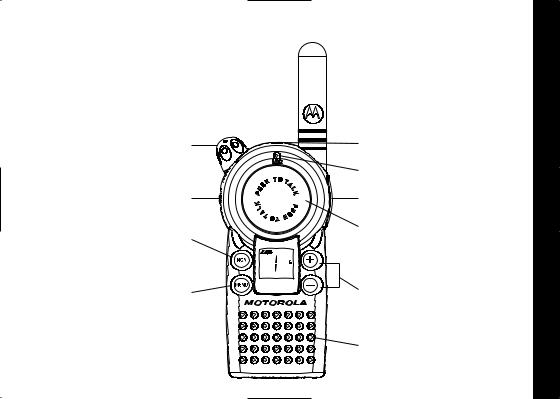
Mise en route
Diagramme de votre radio
Utilisez Ppour: Allumer ou éteindre la radio Régler le volume de la radio
Utilisez Bpour: Transmettre la tonalité d'appel
Utiliser Tpour :
Surveiller la fréquence
Balayer les canaux
Utilisez Spour:
Verrouiller le clavier
Dérouler les menus
Français
Voyant LED
Microphone
Prise accessoire
Utilisez le bouton Appuyer pour
Parler (PTT) pour:
Parler
Enregistrer un paramètre
Utilisez ]et [pour :
Changer les canaux et les codes
Changer les paramètres du menu
Haut-parleur
7

Français
Votre nouvelle radio
Les radios bidirectionnelles Motorola CLS446 fonctionnent sur les fréquences PMR446 et peuvent être employées dans n'importe quel pays où les fréquences PMR446 sont autorisées, conformément aux règlements en vigueur. Ce service de radio bidirectionnelle, sans licence, est prévu pour un emploi non professionnel, en famille et en groupe. L'utilisation de cette radio en dehors du pays où sa distribution a été prévue est soumis aux règlements gouvernementaux et peut être interdit. Lisez ce manuel soigneusement et assurez-vous de bien connaître son fonctionnement avant de l’utiliser.
Veuillez conserver votre reçu de vente original et daté. Pour le service de garantie de votre radio bidirectionnelle Motorola vous devrez fournir une copie de votre reçu de vente daté pour confirmer le statut de garantie.
Mettre en marche et éteindre votre radio
Tournez dans le sens horaire Ppour allumer la radio et régler le volume à un niveau confortable. La radio émettra un bip-bip et la LED rouge et les segments sur l'affichage s’illumineront brièvement. Tournez dans le sens antihoraire Ppour éteindre la radio.
Code de bonne conduite radio
Il est recommandé de surveiller l’activité du canal avant de transmettre afin de s’assurer que vous n'interrompez pas d'autres utilisateurs déjà sur le canal. Appuyez et maintenez enfoncé le Tbrièvement pour surveiller l’activité du canal. Si vous entendez la charge statique, le canal est libre. Appuyez à nouveau sur le Tpour cesser la surveillance.
Piles et recharge de la pile
Votre radio CLS446 fonctionne avec une batterie rechargeable Lithium Ion (Li Ion). Un support de piles est disponible qui permet d’utiliser 3 piles alcalines AAA. Veuillez contacter votre revendeur ou détaillant pour plus d'informations.
Installation de la pile Li Ion
•Appuyez sur la dépression dans le cache de la pile pour relâcher le clips et enlevez-le de la radio en le faisant glisser.
•Insérez la pile, flèches imprimées d'abord, dans le compartiment de la pile et appuyez en place.
•Faites glisser en place le cache de la pile.
8
